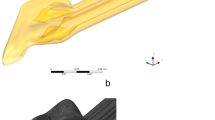Abstract
Here we explore possibilities of the detached eddy simulation models (DES-models) in relation to a human nasal cavity as to a complicated structure of variable section with several bulges and irregularities (paranasal sinuses and turbinate). The three-dimensional geometric model (3D-model) of nasal cavity is perfomed on the results of the computer tomography with the Mercury Amira soft. The convective flows in the 3D-model are given with the Ansys Icem CFD soft. First-ever the nonstationary flow calculations for the 3D-model simulated nasal cavity are performed which aren’t averaged in time, and consider the function of pressure drop in breathing. The results of the simulation are compared with the experimental data obtained for the analogous solid 3D-model.
Similar content being viewed by others
References
K. Keyhani, P. W. Scherer, and M. M. Mozell, J. Biomech. Eng. 117, 429 (1995).
J. Wen, K. Inthavong, Z. F. Tian, J. Y. Tu, C. L. Xue, and C. G. Li, in Proceedings of the 16th Australasian Fluid Mechanics Conference, Crown Plaza, Gold Coast, Australia, 2007, pp. 68–74.
K. Zhao, P. Dalton, G. C. Yang, and P. W. Scherer, Chem. Senses 31 (2), 107 (2006).
J. Pennecot, M. Ruetten, R. Kessler, and C. Wagner, in Proceedings of the 8th World Congress on Computational Mechsnics, Venice, 2008.
B. M. Sagalovich, Physiology and Pathophysiology of the Upper Respiratory Tract (Meditsina, Moscow, 1964).
G. Mlynski, S. Grützenmacher, S. Plontke, B. Mlynski, and C. Lang, Rhinology 39, 197 (2001).
G. Lukyanov, A. Rassadina, and V. Usachev, in Proceedings of the International Conference on Physics and Control PhysCon, 2005, pp. 872–875.
A. A. Voronin, G. N. Luk’yanov, and E. V. Frolov, Nauchno-Tekh. Vestn. Inform. Tekhnol., Mekh. Opt., No. 1(89), 187 (2014).
A. A. Voronin, “Study of Air Flows in Channels and Cavities of Irregular Shape,” Candidate’s Dissertation (St. Petersburg, 2013), pp. 18–79.
H. Tang, J. Y. Tu, H. F. Li, B. Au-Hijleh, C. C. Xue, and C. G. Li, in Proceedings of the 15th Australasian Fluid Mechanics Conference, Sydney, 2004, p.546.
A. A. Voronin, G. N. Luk’yanov, and R. V. Neronov, Nauchno-Tekh. Vestn. Inform. Tekhnol., Mekh. Opt., No. 3(85), 113 (2013).
Author information
Authors and Affiliations
Corresponding author
Additional information
Original Russian Text © G.N. Lukyanov, A.A. Voronin, A.A. Rassadina, 2017, published in Zhurnal Tekhnicheskoi Fiziki, 2017, Vol. 87, No. 3, pp. 462–467.
The article was translated by the authors.
Rights and permissions
About this article
Cite this article
Lukyanov, G.N., Voronin, A.A. & Rassadina, A.A. Simulation of convective flows in irregular channels on the example of the human nasal cavity and paranasal sinuses. Tech. Phys. 62, 484–489 (2017). https://doi.org/10.1134/S1063784217030136
Received:
Published:
Issue Date:
DOI: https://doi.org/10.1134/S1063784217030136




